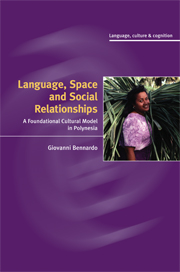Book contents
- Frontmatter
- Contents
- List of figures
- List of tables
- Preface
- Acknowledgments
- List of abbreviations
- 1 A foundational cultural model in Tongan language, culture, and social relationships
- 2 The Kingdom of Tonga: country, people, and language
- Part I Space in Tongan language, culture, and cognition
- Part II Radiality
- Part III Radiality in social relationships
- 9 Radiality and speech about social relationships
- 10 Radiality and mental representations of social relationships
- 11 Radiality in social networks
- 12 A radial mind
- References
- Author Index
- Subject Index
12 - A radial mind
from Part III - Radiality in social relationships
Published online by Cambridge University Press: 19 August 2009
- Frontmatter
- Contents
- List of figures
- List of tables
- Preface
- Acknowledgments
- List of abbreviations
- 1 A foundational cultural model in Tongan language, culture, and social relationships
- 2 The Kingdom of Tonga: country, people, and language
- Part I Space in Tongan language, culture, and cognition
- Part II Radiality
- Part III Radiality in social relationships
- 9 Radiality and speech about social relationships
- 10 Radiality and mental representations of social relationships
- 11 Radiality in social networks
- 12 A radial mind
- References
- Author Index
- Subject Index
Summary
The Tongan radial mind
I started this book with an episode that illustrated the instantiation of the Tongan radiality foundational cultural model in the social relationships domain. The episode highlighted my assistant's preoccupation with others as the cause of her feeling mā ‘shame’ because of the particular event in which she could be participating. This explicitly stated and widely realized mental posture, primary focus on other-than-ego, resonated with a similar organization, i.e., radiality foundational cultural model, characteristic of a number of Tongan domains of knowledge.
First, I introduced extensive evidence about the way in which knowledge about spatial relationships in Tonga is preferentially organized in a radial manner. That is, a specific form of an absolute frame of reference. A fixed point of reference in the field of ego is selected and objects are represented as from or toward that point. The fixed points of reference used are contextually provided by cultural parameters. It is this non-ego based (other-based) mental organization of knowledge in the spatial relationships module (radiality) that is repeated in the preferential organization of other knowledge domains in other mental modules and as such it was eventually proposed as a foundational cultural model.
- Type
- Chapter
- Information
- Language, Space, and Social RelationshipsA Foundational Cultural Model in Polynesia, pp. 339 - 347Publisher: Cambridge University PressPrint publication year: 2009

